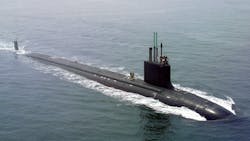Lockheed Martin to provide electronic warfare (EW) systems to enable submarines to locate hostile radar
WASHINGTON – Submarine combat systems experts at Lockheed Martin Corp. will design and prototype U.S. Navy AN/BLQ-10 electronic warfare (EW) systems for Navy submarines under terms of a $7.7 million order announced late last month.
Officials of the Naval Sea Systems Command in Washington are asking the Lockheed Martin Rotary and Mission Systems segment in Syracuse, N.Y., to design, prototype and test the Technical Insertion (TI)-20 AN/BLQ-10 EW system.
The AN/BLQ-10 provides automatic detection, classification, localization, and identification of potentially hostile radar and communications signals at sea.
The AN/BLQ-10 is for Virginia-, Los Angeles-, and Seawolf-class fast-attack submarines, Ohio-class conventional guided-missile submarines, and future Columbia-class ballistic-missile submarines. It is not for existing Ohio-class ballistic-missile submarines.
The AN/BLQ-10 processes signals from the submarine’s imaging mast or periscope when the boat is at periscope depth. It provides threat warning to avoid counter-detection and collision; determines the number and location of targets for subsequent prosecution; and conducts intelligence, surveillance, and reconnaissance (ISR) to support the fleet or battle group.
The program is adopting an open-architecture, incremental development process that fields hardware and software technology insertions every two years, which are called technology insertions. The AN/BLQ-10 blends modular interoperable systems that adhere to open standards with published interfaces.
The system's first technology insertion in 2008 added a subsystem to intercept some low-probability-of-intercept radar signals. Fielded upgrades from the 2010 technology insertions updated commercial off-the-shelf (COTS) processors and displays, and Improved Communications Acquisition and Direction Finding (ICADF) system.
TI-12 upgrades have been fielded on advanced-model Los-Angeles-class attack submarines (SSN 688I) to include new and more powerful computer servers; and standardize the system's cyber security process.
TI-14 upgrades updated COTS processors and displays, and upgraded the system's Electronic Warfare Server First Generation, which provides its electronic support system operator and platform decision makers with improved tactical situational awareness.
TI-20 calls for Lockheed Martin to build an upgraded AN/BLQ-10 for Virginia- and Columbia-class submarine new construction, and in-service Virginia-class modernization.
TI-22 work will provide upgraded AN/BLQ-10 systems for in-service Los Angeles- and Seawolf-class attack submarines, as well as for Ohio-class conventional missile submarines. TI-24 work will build an upgraded AN/BLQ-10 for Virginia-class and Columbia-class new construction, as well as for in-service Virginia-class modernization.
On this order Lockheed Martin will do the work in Syracuse, N.Y., and should be finished by February 2021. For more information contact Lockheed Martin Rotary and Mission Systems online at www.lockheedmartin.com, or Naval Sea Systems Command at www.navsea.navy.mil.
